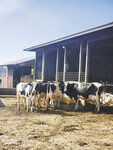

WEST SALEM, Wis. — The Jandts thought their problems were over when they fixed their stray voltage issues in 2017. Unfortunately, there was another problem lurking in their water supply.
“When we fixed our stray voltage problems, feed intake increased, but the milk never did,” Joe Jandt said. “Components got better, but the pounds never went up. They were eating more feed, but they never came back (in milk production).”
Jandt milks 160 cows with his wife, Jennifer, and their children, Gabe, Gibson and Ellison. Cows are housed in free stalls and milked in a stanchion barn.
A nutritionist tried to help the Jandts determine what could be preventing production from recovering. After adjusting the ration, testing feed and double-checking the electrical system, they resorted to a simple water sample. The results indicated there was a high level of iron in the water.
To be considered safe for cows, it is recommended that iron levels in water be under 0.3 parts per million. The iron in the Jandts’ water supply was 3.6 parts per million, which is 12 times higher than the threshold for concern.
“There’s not a lot of help out there with how to fix it,” Jandt said. “It kind of felt the same way as stray voltage.”
A high iron level in drinking water binds minerals and prevents proper absorption. The iron in treated water does not disappear; however, it transitions iron from a soluble mineral to an insoluble mineral, allowing the cows to absorb the other minerals in the water.
“When they drink the water with the iron in it, it messes up the way they metabolize those minerals,” Jandt said. “A lot of times, when people don’t realize they have this problem, they end up overfeeding minerals in the diet.”
Their route supply company at the time helped the Jandts research ways to make the water safe. The mechanical iron separators they found were horribly expensive, Jandt said. Finally, they discovered that a peroxide injector could take care of the problem in the most cost-effective way.
A meter was installed on the pipe that supplies water to the cows. The meter measures the output of water from the well and then sends a signal to the controller mounted on the milkhouse wall. This prompts a pump to add chemicals. A 55-gallon barrel of 34.5% peroxide feeds the pump. Treated water then flows to the waterers.
The system includes a backflow preventer, so treated water is unable to feed back into the well. Since it is illegal to treat a well, measures had to be taken to prevent the peroxide from reaching the main water supply. The preventer was about one-third of the cost of the project, and the Jandts pay to get it inspected every year.
Since the water that is going through the backflow preventer is untreated, the high iron levels cause wear on the device. It has lasted three years, but Jandt expects to have to replace it before the next inspection.
The backflow preventer was about $1,200, and the entire project cost around $3,600. The barrel of peroxide lasts about 3-4 months and costs $425. Their route supply company supplies the product.
When the system was first installed, it took a few weeks for the Jandts to see results in the cows. When there is a high level of iron in the water for a long time, the level of peroxide going into the water is set at a higher rate to begin with. After a couple of weeks, the rate is dialed down. Eventually, it reaches a maintenance level.
Jandt said the automatic waterers are now cleaner, and all the iron bacteria that had built up in the waters disappeared after the peroxide treatment, resulting in healthier water for the cows.
Now that they have used the system for three years, the cows have developed a new standard, and they suffer tremendously if the peroxide barrel runs dry. When the system was initially used, the cows would drop 1,000 pounds of milk in a day if the barrel ran dry. When the peroxide barrel was replaced, production was back up the next day.
The Jandts recently ran out of peroxide again and did not realize it right away. They had three cows freshen, and the calves were born with their front legs curled under. They struggled to figure out why they were so weak. When their nutritionist mentioned a selenium deficiency, they realized they had run out of peroxide.
“The peroxide was out, and the iron was back,” Jandt said. “It certainly affected the cows before we had the peroxide injector, but now that we’ve done it, they can’t be without it.”
Comments
No comments on this item Please log in to comment by clicking here